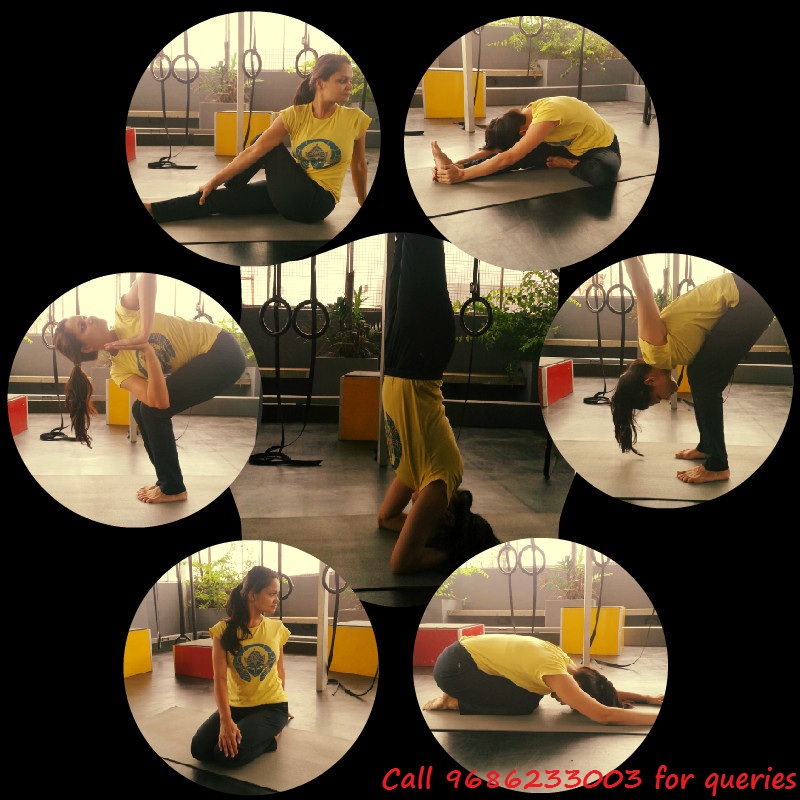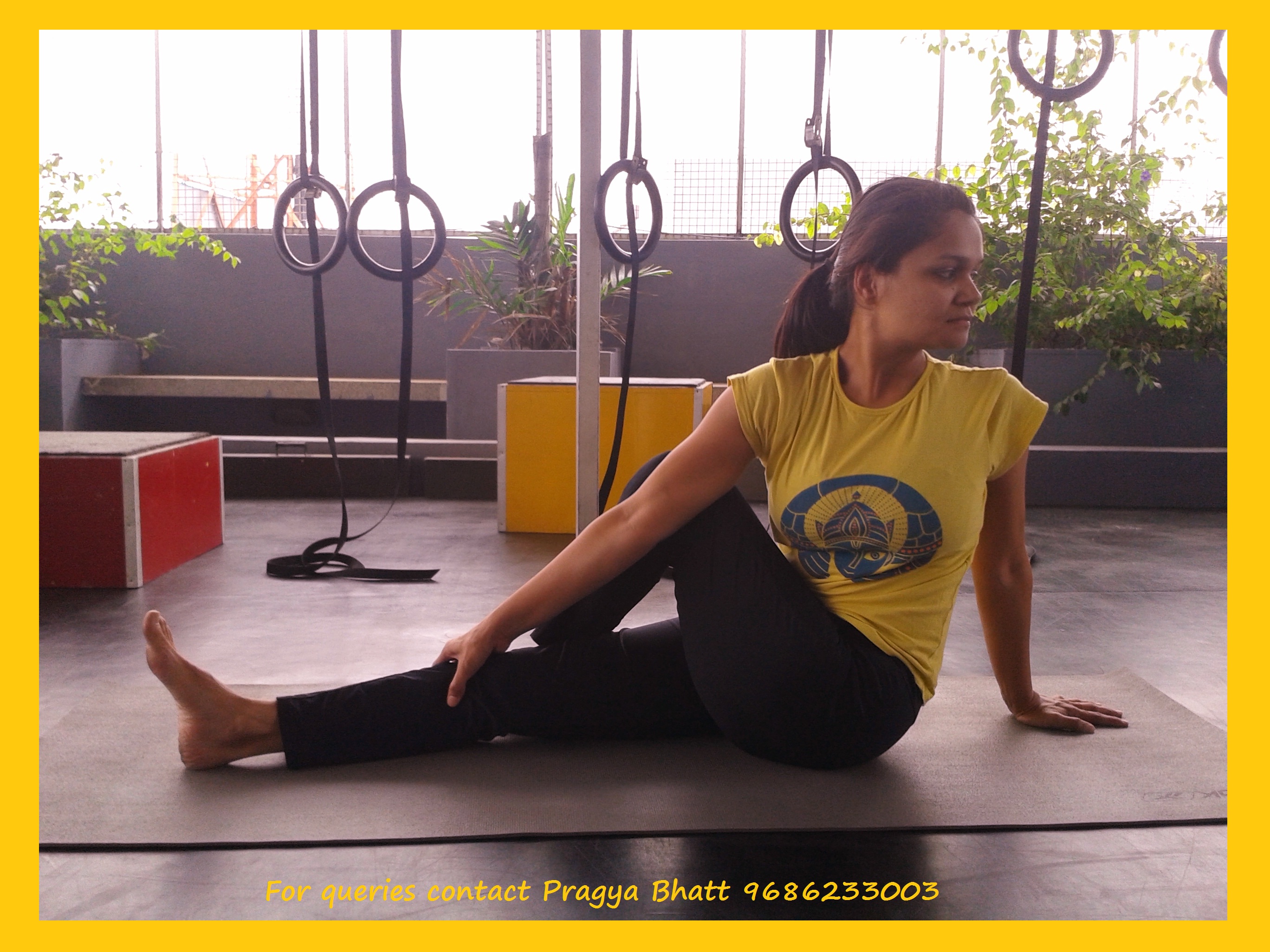A video on how to practice the Bandhas. These can be incorporated in your daily yoga practice.
I just realized that a lot of people might not be aware of my YouTube channel, but might still be interested in my videos about Yoga asanas. So I’ll begin with sharing one about the Simhasana, which is a great pose to prevent wrinkles and keep your throat muscles healthy. I’ve spoken about all the benefits of the Simhasana in the video.
Happy viewing and don’t forget to subscribe and leave a comment!
Janu Sirshasana (Head to Knee Pose)
How To:
- Sit with both legs spread out in front of you. Make sure you’re balanced on your buttocks with your feet together and your toes pointing upwards.
- Start with the left leg. Bend it at the knee and bring your foot as close to the groin region as possible. Make sure the sole of your foot is parallel to the right thigh. Also make sure the left knee is on the floor and not floating in the air.
- Inhale at this position.
- Now exhaling start to reach out to grasp your toes. Don’t worry if you are unable to grab your toes. Make sure not to curve your back. Imagine that your spine is extending upwards towards the ceiling and you need to work on making your back concave so that your chest is slightly outwards. You want to aim at getting your abdomen on the thigh.
- Go as far forward as is comfortable and breathe for some time in this pose.
- Once you’re comfortable take your awareness to your torso. You want to try to bring the left side of your body close to the right leg and the right side a little away from the leg.
- Make sure not to hunch your shoulders. Throw your shoulders back.
- Inhale as you come up.
- Repeat on the left side.
Variations
- If you’re unable to grab your toes you can also use a belt. String the belt around the balls of your feet to ensure that your toes continue to point upwards as you come down.
- If the knee of the folded leg doesn’t touch the floor, you can place a cushion or a folded blanket under it.
- Pregnant women should practice this only until the second trimester.
Benefits
- Great stretch for your back, legs and shoulders.
- Increases flexibility of the hip joint.
- Massages the kidneys, spleen, pancreas and liver, thereby stimulating their functioning and helping to detoxify the system.
- Stimulates digestion by massaging the abdominal organs and the pelvic region.
- Relieves menstrual pain.
- Eases the effects of stress, tension and strain on your body and relaxes the mind.
- Helps in promoting good posture by correcting the curvature of the spine.
- Helps in alleviating depression and anxiety because it tones and massages the adrenal glands.
- Great to alleviate fatigue.
- Can help in treating symptoms of high blood pressure and insomnia.
Contraindications
- Practice with caution if you have asthma or diarrhoea.
- Practice with caution if you have slipped disc, sciatica or hernia.
Utkatasana (Chair Pose) with a Twist
How To:
- Start with your legs together, toes touching, knees touching, back straight, shoulders relaxed.
- Start to inhale and as you inhale bring your hands up and over your head making sure to align your arms with your ears.
- Lock your elbows.
- As you exhale sink down as though you were sitting in a chair.
- Make sure that you can see your toes and that your knees are not leaning too far forward and covering your toes. Also make sure that your knees are together. Your knees should be directly above your ankles.
- Hold your torso as erect as possible. [Note: If you are new to this pose, you can stand with your feet hip-width apart.]
- Now bring your hands into the Namaskar mudra in front of your chest.
- Twist your torso to the right so that your left elbow makes contact with the outer edge of the right knee.
- Leverage the strength of your left arm to gently push your chest forward. Look up at the ceiling.
Benefits
- Great to increase flexibility of the spine.
- Strengthens legs, hips and back.
- Helps in alleviating flat feet.
- Great to stretch the torso, shoulders and chest.
- Stretches your abdominal muscles as well.
- Great for sciatica and for arthritis of knees and ankles.
- Tones the abdominal organs.
Contraindications
- Practice with caution during menstruation.
- Those with lower back problems should be careful when practicing this posture.
- Avoid if you have a meniscus problem in the knee or any other knee problems.
Marichyasana (The Spinal Twist)
How To
- Sit on the floor with legs extended out in front of you. Make sure your toes point straight up and knees are pushed into the ground. Make sure your back is absolutely straight.
- Start with the right leg. Bend the right leg at the knee and place the right foot on the inside of the left knee.
- Take the right hand and place it behind you so that your torso also twists to the right.
- Keep the left arm straight and elbow locked and place the elbow on the outside of the right knee. Hold on to the left knee.
- Now push slightly with the left arm and deepen your twist. Exhale as you do so.
- Look over your right shoulder.
- Repeat on the left side as well.
Variations
- This pose can also be performed without crossing the bent leg over to the inside of the other knee.
- Instead of holding the opposite knee you can also just keep your elbow bent
Benefits
- Great for digestion.
- Helps flush toxins out of your system.
- Revitalizes you.
- Helps in reducing the fat around the sides and therefore gives shape to your body.
- Tones and massages the abdominal organs.
- Helps to improve the functioning of liver, spleen, pancreas, kidneys and intestines.
- Helps to relieve backache.
- Relieves lumbago.
- Increases the flexibility of the neck and shoulders.
- Helps to improve the alignment of the spinal cord and keeps it supple.
- Cures indigestion.
- Relieves flatulence.
Contraindications
- Do not practice if you have diarrhoea.
- Pregnant women shouldn’t practice this asana.

Explanations for these coming soon! Keep reading!!!
Recently I had the chance of getting to know one of my students over coffee. Despite her hectic schedule this wonderful woman took me to her home and offered me amazingly good filter coffee and healthy mid-morning snacks to go along with it. She was considerate enough to ask me whether I eat once I’m done with the class and what I eat if I do. During the course of our conversation I realized that by virtue of being a wife and a mother, there were so many unavoidable responsibilities that she was loaded with, and that she probably had to juggle her schedule a bit to accomodate our little coffee break. She has two daughters in high school, a family business, older in-laws to take care of, and of course the everyday hassles of running a house. Looking at her I wondered where she got the energy from. She seemed the embodiment of ‘Ces’t la vie’…with a smile.
That day I learned from her that if you accept your lot in life with ease then you make space for peace and you are able to deal with things in a calmer manner. Having no time is the bane of modern existence, but sometimes in the middle of it all you meet some individuals who manage to stay focused and calm. These individuals are busy, have responsibilities, and with that, numerous sources of stress in their lives. Yet, they manage. How?
They create an oasis of calm and peace in which they reside and refuel. According to yogic philosophy, everything is an illusion. An event is just a combination of moments put together. Whether the event is good or bad depends on who it happens to and how that person responds to it. So if you choose to respond with peace and calm, you significantly reduce the damage caused by events over which you sometimes have no control.
The valuable insight I received from our chat over coffee:
1. There are sources of stress, worry, strain and anger in everyone’s life. Waiting for the source of stress in your life to disappear so that you can live peacefully again is in vain because there will always be something to worry about.
2. The best way to deal with life is to create reserves of calm and peace within yourself by recognizing that you need to spend time by yourself. Whether it’s going for your closest yoga class, or doing some deep breathing for 5 minutes before you start your day, or reading the paper with your coffee and watching the world wake up…whatever it is, you need to take time out for your body and mind.
The philosophy of yoga has 8 limbs (ashta anga = eight limbs). The first two of these are:
1. Yama – These are the set of ‘don’ts’. They can also be considered to be universal moral commandments. Patanjali laid down these principles as general ethical principles that must be followed on a daily basis. These are:
- Ahimsa (non violence) – refraining from any kind of violence, thought, deed action. This includes not harming yourself.
- Truth (satya)
- Non stealing (asteya)- this deals with controlling and reducing desires and wants. The observance of asteya gives the practitioner freedom from avarice.
- Continence (brahmacharya) – refraining from sex in mind and body. This principle has many interpretations. Purists believe this means no sex, period. However, yoga is not a practice exclusively for celibates. Taking this into consideration, this principle implies abstaining from ‘immoral’ acts of sex. Morals are a function of the society we live in and therefore might differ from one person to the next. However, (generally speaking) sex which is outside marriage, or without the consent of the other person, sex as a means of wielding power, sex to harm the other person….is ‘immoral’. Brahmacharya deals with a disciplined sexual life rather than a non-existent one.
- Non covetousness (aparigraha) – not desiring things which are not necessary for life. This includes emotional and intellectual possessiveness.
2. Niyama – These are the set of ‘dos’. Practicing these leads to self restraint and thereby self purification. These are:
- Saucha – purity/cleanliness. There are two kinds of purity which must be strived for. These are:
- External: External purity implies purity of behavior and habits. Cleaniliness of your physical body and your surroundings. So things such as showering daily and wearing clean clothes and changing your socks :).
- Internal: Internal purity deal with getting rid of any negative or harmful emotion that might be bottled up or that might be manifesting itself on a daily basis. These negative emotions are:
- *Kama – passion
- *Krodha – anger
- *Lobha – greed
- *Moha – infatuation
- *Mada – pride
- *Matsarya – malice and envy
- Santosa – contentment
- Tapas – austerity
- Svadhyaya – study of scriptures/one self
- Isvara pranidhana – surrender to the lord of all our actions
Because yoga is the path to enlightenment, it is important, necessary and imperative that yama and niyama be followed. Without these yoga becomes just a physical practice of asanas. That’s like having a Blackberry and only using it to make and receive calls. However, a Blackberry can be used to schedule meetings, check your mail, chat, listen to music and so on and so forth. If yoga is practiced with a view to only reap the physical benefits, then you are merely scratching the surface of an ancient philosophy which can add so much value to your life.
So to sum up – practice your yama and niyama!!! 🙂
It’s hard to stay focussed and committed. To any kind of routine. Specially the kind of routine which may require you to wake up early and be on time for a fitness class. If your class is later in the day then you have to ignore every single excuse that might crop up for why you can’t be at the class, and just go to it. We all know we feel better post our yoga sessions, but why do so many people start with being regular and then lose steam? I’m not sure. But maybe there are a few things we can do to stay motivated, and at least to get to class despite not feeling motivated.
1. Join a class. A friend of mine used to go to the most expensive classes available because she would feel compelled to go so as not to waste all her hard earned money. It worked for her, it might for you too!
2. Whether the class is expensive or relatively cheap, make friends with people in your class. Or, better yet, join a class with a friend. So when you feel like staying in bed, then there will be someone to pull you out and into class.
3. If going to class is not possible for you then follow one of the numerous health/fitness blogs online and do routines in the comfort of your own home. But this does require you to prowl the web looking for videos which inspire you. These videos should feature routines and instructors who you want to spend an hour with every day. You may eventually get bored of the same videos, or you might exhaust someone’s videos. Then you need to start your research all over again and find other videos which will keep you on track.
As a start watch my videos and give me cmments and suggestions for the kind of videos that you feel can help you!
Mudra is a Sanskrit word which means ‘to lock’ or ‘to seal’. The word ‘mudra’ signifies hand gestures, or even symbols. Mudras are an integral part of a yoga practice in that they enable you to control the flow of prana, or the life force, thereby making you more energetic and full of vitality. In addition to this mudras help you lock energy inside your body so that you can utilize it, rather than letting it dissipate.
The fingers of the hands represent the different elements of the earth. Taken together these 5 elements are called the panch tattvas. These are:



